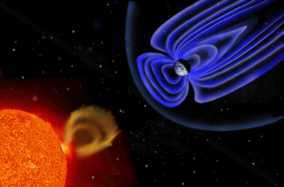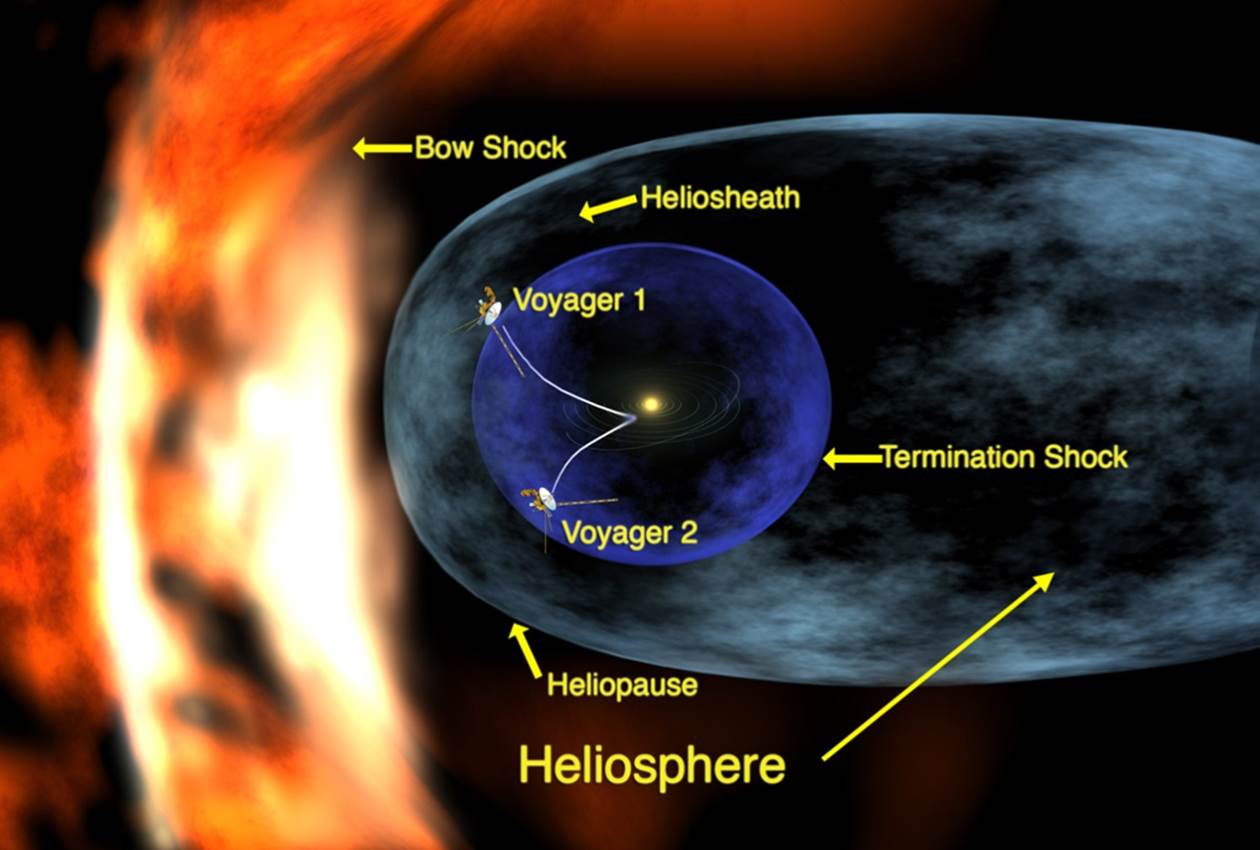Space Plasma Physics
SPACE PHYSICS
 |
| Artist depiction of Sun and Earth's magnetosphere. (http://www-spof.gsfc.nasa.gov/Education/Intro.html) |
Space physics in Auburn University's Physics Department focuses upon the region in the space around the Earth called the magnetosphere. This region is formed by the interaction of the solar wind and the Earth's magnetic field. It extends from approximately 10 Earth radii toward the Sun to a tail extending 100's of Earth radii away from the Sun. (An Earth radius is 6371 km.) This dynamic region is filled with plasma, electric and magnetic fields, and electromagnetic waves. It is responsible for one of nature's most beautiful scenes, i.e., the aurora at both the north and south polar regions. It is also home to the many satellites that are so vital to our current way of life. Under certain conditions, the impact of the solar wind in the space around the Earth is especially strong resulting in geomagnetic storms that can interfere with the operation of our satellites. By advancing our knowledge of this important region, we are able to better understand our region of the solar system and to develop new understanding of the basic principles that determine the behavior of plasmas that fill the universe.
Global simulations of the Earth's magnetosphere using the world's largest and fastest computational resources are one of the major areas of emphasis in the Auburn Physics Space Science Group. Specific active research investigations are:
(1) Global hybrid simulations of interaction between the solar wind and the Earth’s magnetosphere:
Large-scale parallel computations using 3-D global hybrid models (fully kinetic ions and an electron fluid) are being carried out for the interaction between the solar wind and the Earth’s magnetosphere. Various dayside processes are addressed, including global ion kinetic physics associated with the magnetic reconnection/FTEs at the magnetopause, foreshock waves of the quasi-parallel shock and their self-consistent nonlinear interaction with the magnetopause, mode conversion and wave-particle diffusive transport at the magnetopause, and the coupling between the foreshock Fermi-accelerated diffuse ions and the cusp energetic ions.
In addition, interaction between the bow shock/magnetosphere and an interplanetary discontinuity is simulated with the 3-D global hybrid code. Our results show the generation of MHD discontinuities, shock waves, pressure pulses, hot flow anomalies (HFAs), and the magnetospheric traveling convection vortices by the interaction.
(2) Theoretical/computational studies of the fundamental plasma physics:
The interaction between foreshock waves and the magnetopause has been suggested to lead to the generation of ULF waves and plasma diffusive transport at the magnetopause. Hybrid simulations are carried out to investigate the physics of mode conversion from fast mode compressional waves to kinetic Alfven waves (KAWs). Our 3-D hybrid simulation shows for the first time the generation of KAWs dominated by perpendicular and azimuthal wave vectors when the amplitude of KAWs generated by linear mode conversion becomes large enough to drive a nonlinear parametric decay process. The results are fundamentally important to the transport processes at plasma boundary in space and laboratory plasmas. Our simulation also shows the generation of Alfven and KAWs by ion beam-plasma interaction.
(3) Gyrokinetic electron and fully-kinetic ion (GeFi) particle simulations of collisionless plasma processes:
An innovative particle simulation scheme, the GeFi scheme, has been developed, in which electrons are treated as gyrokinetic (GK) particles and ions follow fully kinetic (FK) equations. The GeFi models are particularly suitable for plasma processes in which the wave modes from Alfven to whistler/low-hybrid frequencies need to be handled on an equal footing. Using the GeFi models, we are investigating the physics of collisionless magnetic reconnection under a finite guide magnetic field with a realistic ion-to-electron mass ratio. Another important application of the GeFi model is the investigation of the nonlinear low-hybrid physics in space and fusion laboratory plasmas.
(4) Particle-in-Cell Simulations
 |
| Illustration of the Heliosphere, the area of space dominated by our Sun. (http://www-spof.gsfc.nasa.gov/Education/Intro.html) |
In order to study (a) wave excitation through various plasma instabilities in the magnetosphere, (b) relativistic electron scattering in the radiation belts, and particle acceleration in the auroral region, particle-in-cell (PIC) simulations in which the particle nature of both electrons and ions is treated explicitly are carried out. Studies of plasma processes in the interaction region between the heliosphere and the interstellar medium, including the termination shock are also an active area of research.
(5) Energetic Neutral Atom Imaging of the Inner Magnetosphere
To motivate and validate the simulations of the Earth's magnetosphere, it is necessary to utilize the extensive collections of satellite data obtained from satellites orbiting the Earth. Typically today's satellites contain a suite of instruments that are capable of making incredibly detailed measurements of the plasma and electric and magnetic fields at the satellite's ever changing location. It has then been the task of scientist to construct a global picture from these point measurements. Beginning in the year 2000, satellites utilizing the technique of Energetic Neutral Atom (ENA) imaging have been taking "pictures" of the inner magnetosphere using this technique. The particle of most interest are, of course, the charged ions and electrons. But because charged particles are forced to travel in curved paths because of the magnetic field, they are not suitable imaging targets. The technique of ENA imaging takes advantage of the existence of a cold neutral hydrogen gas in the inner magnetosphere. The high energy (1-100 keV) ions of interest charge exchange with the neutral hydrogen becoming neutral themselves and subsequently moving in straight lines. Thus an ENA image formed by an array of pixels collecting high energy neutrals along a line of sight can be formed. The work at Auburn focuses upon interpreting these images. This requires the solution of integral equations using techniques based upon Bayesian statistics. At this time we are working with ENA images from the TWINS mission and comparing results with in-situ measurements from THEMIS satellites and calculation using the CRCM model.
